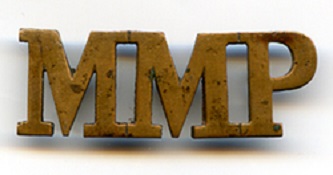
Great Britain
The senior officer in Britain’s military police and the person responsible for maintenance of order and discipline is known as the Provost Marshal (PM), this beingan appointment rather than a rank, below whom sat various Assistant Provost Marshals (APMs) and Deputy Assistant Provost Marshals (DAPMs). The position is one of the oldest in the British Army, long pre-dating the creation of the Military Police per se, and known in fact to date back to at least the 13th Century. As far back as the reign of Henry VIII, the Provost Marshal was provided with a body of soldiers known as a Provost Company, the term still used today for the basic military police unit.
The first formal military police unit in the British army was created in 1813, when the Staff Corps of Cavalry was formed. Originally consisting of four troops, each of 11 officers and 132 other ranks, they served during the Peninsular War but were disbanded in 1814, reformed again in 1815 and finally disbanded in 1819. A Mounted Military Police (MMP) was formed on 13 June 1855, from men with "at least 5 years service, of sober habits, intelligent, active and capable of being discrete", specifically for service in the UK, to police the new Army garrison at Aldershot.
On 1 August 1877, the MMP, its name now slightly altered to Military Mounted Police, was established as a distinct individual Corps in its own right for service both in the UK and overseas

The shoulder title for the MMP was also used as a cap badge.
In 1882, a complementary Military Foot Police (MFP) was created for service in Egypt., drawing its personnel principally from men with former civilian police service.
In 1885, it too was formally established as a Corps in its own right.
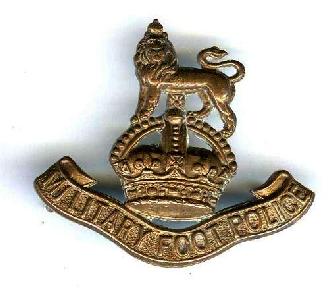
A Military Foot Police cap badge was created but it is uncertain to what extent it was ever actually used .
No photographs of it in use are known to exist.
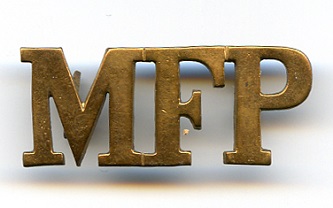
Like its MMP counterpart, the MFP shoulder title was also used as a cap badge.
At the start of World War One, Britain possessed the grand total of 761 Military Policemen, so the two Military Police Corps (MMP and MFP) went through a phase of rapid expansion during that conflict and by November 1918 there were approximately 25,000 serving MPs.
In 1927, the Military Mounted Police and Military Foot Police were formally amalgamated to form the Corps of Military Police (CMP)
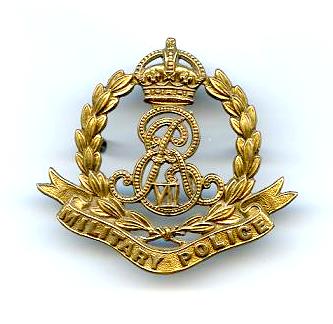
Military Police Cap Badge with the Cypher of KIng Edward VII.
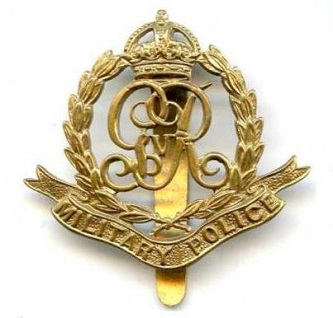
Military Police Cap Badge with Cypher of King George V.
In 1937 a new Branch of the Corps was formed, the Field Security Police (FSP) who wore green rather than the distinctive red cover on their caps, followed in 1941 by the Vulnerable Points Wing (VP) with blue hat covers , Traffic Control (TC) with white hat covers and finally a Ports Provost Wing (PP).
World War Two also saw the creation of the Special Investigations Branch (SIB), the plain clothes MPs recruited from the CID of the Metropolitan Police.
Through World War Two, members of the CMP served on every front, usually amongst the “first in and last out” in every campaign. Provost units were amongst those that landed in Normandy on 6 June 1944.
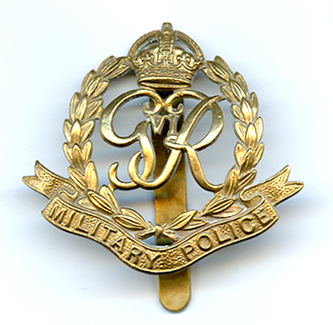
MIlitary Police Cap Badge with Cypher of King George VI
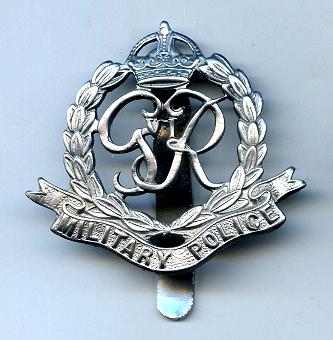
Military Police Cap Badge with Cypher for King George VI silvered.
Unofficial modification to the standard brass badge worn by some WO1s

Wartime "Economy" Pattern Military Police Cap Badge in Plastic
According to General Sir Myles Dempsey :- “The Military Policeman became so well known a figure on every road to the battlefield that his presence became taken for granted. Few soldiers as they hurried over a bridge, which was a regular target for the enemy, gave much thought to the man whose duty it was to be there for hours on end, directing the traffic and ensuring its rapid passage”.
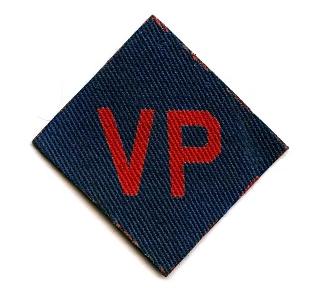

Vulnerable Points (VP) and Traffic Control (TC) patches worn just below the shoulder title.
Both were made in Printed and Embroidered form.
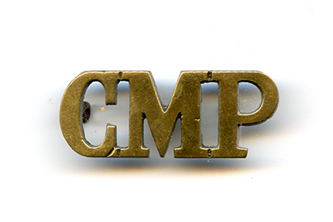
Corps of MIlitary Police shoulder title in brass.
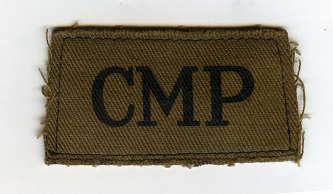
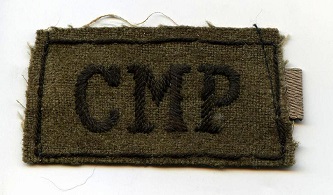
CMP shoulder strap slip on slides in printed and embroidered form.


CMP shoulder titles for the battledress tunic in printed and embroidered form.
In 1946, in recognition of its outstanding record of service during World War Two, King George VI granted the prefix “Royal” to the Corps of Military Police, henceforth known as the Royal Military Police (RMP).
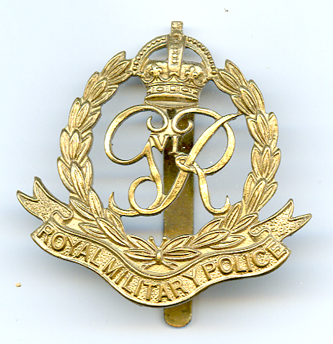
Military Police Cap Badge with Cypher for King George VI and prefix "Royal"
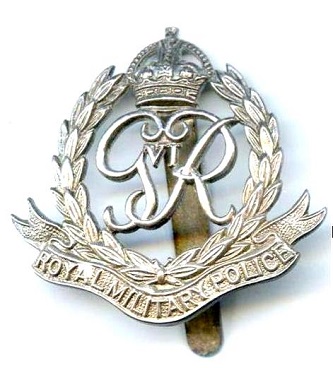
Military Police Cap Badge in Silver with Cypher for King George VI and prefix "Royal"
Although the RMP did not have its own officers at this point, WO1s and some attached officers wore the badge in silver
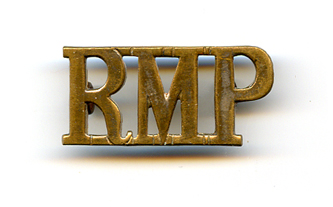
RMP Shoulder Title for Royal Military Police
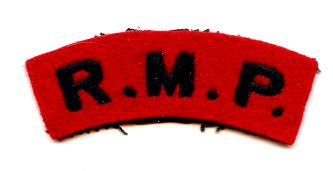
Embroidered RMP shoulder title for the battledress.
Collar Dogs only came into being for the Military Police after WW2 with the advent of the GVIR "Royal" prefix badges.
NCO collar dog and cap badge
Officer / WO1 collar dog and cap badge
Following the change of Monarch in 1953, the badge was altered to show the new Royal cipher EIIR in the centre with the Queens Crown above. It was initially stamped from Brass.
Brass EIIR badge with its associated Collar Dog.
Badges for Officers were in a silver plated finish.
Officers Silver Plated Cap and Collar Badges.
The Brass versions of the insignia were replaced by Anodised Aluminium in 1960. The gilt colour used was often very pale so as to appear almost silver in some images.
Anodised Aluminium versions of the Cap and Collar Badges.
One further , related badge is of interest. The Military Provost Guard Service (MPGS), created in the late 1990s, provides armed security at military bases in the UK and like the Royal Military Police, is now part of the Adjutant Generals Corps. The force is recruited from soldiers with at least three years previous experience. Their badge is in Anodised Aluminium and consists of a Lion above the Queens Crown over Crossed Keys with a scroll bearing the legend "Military Provost Guard Service"
Field Security Police
Orginally part of the Corps of MIlitary Police, FSP personnel were known as the "Green Caps" as opposed to "Redcaps" due to the green covers on the SD cap,
They were soon absobed into the new Intelligence Corps, but during their time as part of the CMP many wore the regular CMP badge but with the "Military POlice" scroll cut off or in some cases with the scroll retained but with the lettering ground off.
FSP cap badge with scroll removed completely.
FSP Shoulder Title
ATS Provost
Female provost personnel during WW2 served in the ATS (Auxiliary Territorial Service) and wore the cap and collar insignia of the ATS.They did however wear the regulation MP armband and a shoulder title with the word "Provost" in black on red. The red cap cover was also worn.
Gurkha Military Police
The Gurkha Military Police was formed in 1949 and served through until 1970 when it was disbanded. Initially it existed as the Gurkha Provost Company of the Royal Military Police, being renamed as the Gurkha Military Police in 1957.An unofficial badge was produced without authority, and worn until the introduction of the regulation badge, which was closely modelled on the RMP cap badge but with a smaller Royal cipher to accomodate the insertion of a pair of crossed Kukris below. The legend on the banner read "Gurkha Military Police".
Gurkha Military Police Cap Badge in Anodised Aluminium
As well as the regulation badge in Anodised Aluminium, examples are known with both a silvered finish and a bronzed finish both purportedly for Officers. As both types are heavily reproduced it is not clear whether these copies were based on genuine examples with such finishes, or are wholly fictitious. Both of these types should therefore be treated with caution.
Silvered "Officers" Cap Badge, probable copy.
Bronzed "Officers" Cap Badge, probable fake.
From 1957 onwards, the "RMP" shoulder title was replaced with "GMP"
Royal Marines Police
The Royal Marines Police was formed in 1922, providing security and maintaining discipline in Naval Dockyard areas. Recruitment was direct from serving or former Royal Marines.
The cap badge consisted of the usual wreathed globe of the Royal Marines, but without the crown at the top and the whole was stamped from white metal rather than having the usual gilt finish.
An "RMP" shoulder title identical to that of the Army's Royal Military Police but once again in white metal rather than in gilt Brass, was also worn.
The original Royal Marines Police was disbanded in 1949 with the advent of the Admiralty Constabulary. Much of the type of duties originally envisaged for the Royal Marines Police would eventually be carried out by the Ministry of Defence (MOD) Police.Although a subsequent Royal Marines Police Troop was formed, tasked with operational duties similar to the Army's Military Police such as directing convoy movements, route marking, convoy escorts and cp duties, it too eventually lost its independence, being absorbed for administrative purposes into the Royal Navy Police in 2009.